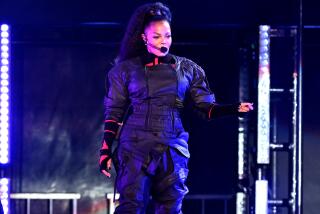Janetvision: Rhythm Isn’t in the Program
- Share via
IRVINE — You knew a big extravaganza was in the offing when the sort of excited, stentorian hype-mongering voice only heard in old movie trailers started huffing and puffing about “the rhythm” before a single beat of Janet Jackson’s show had even been struck.
“The rhythm. The rhythm controls us . . . the rhythm is here . . . love together in one rhythm . . . “
The extravaganza arrived with all the flash one expected, and more. But it wasn’t about rhythm, or any other musical element that might forge a sense of united purpose and shared experience between audience and performer.
Jackson turned her fans into consumers of visuals, not participants in a shared experience of rhythm. This wasn’t “Soul Train,” where the audience is invited to groove along, but “The Outer Limits,” where somebody else takes control of the programming, and you sit back and watch.
For 100 minutes Tuesday night, a near-capacity house at Irvine Meadows did just that. It stood and watched, waiting to see what fantasy would be enacted next, what entertainment conceived, packaged, and precision-delivered by Jackson would be served up for inspection.
This was television by other means, and watching television is the most passive form of entertainment. You could even watch most of Jackson’s show on TV, thanks to the three large screens that dominated the multilevel stage set, and the two even larger ones flanking the stage.
Jackson’s show was entertaining, on a grand scale befitting a TV variety show or a particularly spectacular Las Vegas floor show. Flash pots went off. A changing array of colorful, sexy costumes appeared. A phalanx of supporting dancers, lithe, comely and nimble, bobbed, skipped, strutted and whirled in combination with the lithe, comely, nimble star.
The machinery didn’t allow Jackson to be personal, or impressively musical. It was, in fact, rather short on real, motivating R & B. The show’s function clearly was not to be thought-provoking. It was aimed at the Chauncy Gardener in us all, the part that just likes to watch.
*
For sheer spectacle, it would be hard to top “This Time,” which Jackson turned into a morality play decked out with all the stormy trappings of an old Hollywood horror film. Burning candles appeared out of nowhere; a spooky fog enveloped the scene. The star presided as a mysterious, regal vampirette in an elaborate, velveteen robe.
The scenario called for a vulnerable-looking, barefoot female dancer in a red dress to be smacked about by a brutish Stanley Kowalski type, only to emerge triumphant in the end.
Under the approving eye of regal Janet, who intoned the chorus, “This time you’ve gone too far, this time I’m not gonna stay, this time you have got to pay,” the woman in red got the drop on her attacker and beat him senseless. Call it even? Nah. With the now-helpless Stanley restrained by a cadre of woman assistants, the lady in red committed a form of Bobbitry, finishing him off by slamming a spike into his heart.
Maybe Jackson figures that everyone will be so swept up by the spectacle of it all that no one will question the morality of a morality play in which cold-blooded murder is made to seem like just deserts for spousal abuse.
One also wonders whether Jackson has any queasiness, in light of the murder allegations against O.J. Simpson, about casting a black man and a white woman in a violent vignette that ends in the death penalty.
But Jackson is in control of the picture, and we’re not supposed to ask any questions about Janetvision, much less relate it to a world off screen.
Of course, Jackson isn’t “doing” social consciousness these days--that was her last album, “Rhythm Nation 1814.” On this album, “janet,” she’s doing sex. For $25, you could buy a T-shirt showing the Rolling Stone magazine cover shot of Jackson in unzipped jeans and nothing on above the belly button except for her lover’s strategically placed hands.
There were no such revelations on stage, and nothing all that risque.
“Throb” would have worked as a good, steamy funk workout even without a canned track of orgasmic noises (musically, it was one of the hottest numbers in a show that settled into too many smooth, cool, mid-tempo grooves and could have used more heat).
“Let’s Wait Awhile,” a 1986-vintage song in which a virginal protagonist sweetly tells an eager boyfriend to cool his jets, is considered Jackson’s statement in favor of chastity. Here, she caressed herself as she sang, as if to suggest a fast-approaching, hard-to-contain sexual ripeness.
*
For the smoothly seductive “Any Time, Any Place,” Jackson used the old ploy of pulling someone out of the crowd to serve as designated love-interest, creating an illusion of availability on the star’s part. She cooed and rubbed while the lucky guy acted embarrassed, then amorous.
In a show that left nothing to chance, he was almost certainly a plant. If not, given today’s legal climate, Jackson’s public beneath-the-shirt fondling of the fellow’s stomach and chest might give him a sexual harassment claim against a very, very rich defendant, supported by 14,000 or so eyewitnesses.
You can imagine the testimony: “I may have looked as if I was enjoying it at the time, your honor, but now I feel tremendous mental pain and anguish over having been exploited as a sex object in front of so many people.” Jackson would surely pay a cool sum in settlement just to make such a case disappear.
Sometimes there was just too much to watch.
In a medley of “When I Think of You,” “Escapade” and “Miss You Much,” an array of figures in dazzling jester’s motley danced capriciously around the star, while a huge, inflated clown figure lolled at the back of the stage.
The eye-glutting staging might have had more charm if it had been more tightly focused on Jackson and two or three dancing sprites, instead of six or seven. It was charming, though, to see the casual repartee between Jackson and her dancers.
Their wordless byplay seemed less a choreographed response than an expression of genuine fondness. That playful quality was most evident during a loosely structured encore in which Jackson, dressed down in jeans and flannel, seemed to be hanging out in the ‘hood with her pals, just for the fun of it.
The worst bit of staging was the much-discussed crying jag that begins on cue midway through the lovelorn ballad, “Again.” Everyone knew it was coming: “Cry, Janet, cry,” yelled one fan as Jackson neared her scripted breakdown.
When it came, Jackson’s face clouded over, her voice trembled, her body shook, and, finally, she buried her head in her lap. The problem wasn’t that this embarrassing display was calculated--even rock’s icon of spontaneity, Neil Young, has been known to repeat a sensational gesture from night to night for emotional effect.
The problem was that it was bad acting of the worst sort. Maybe if Jackson saw an Emmylou Harris concert, the idea would sink in that sorrow rendered with a woman’s dignity is more moving than sorrow rendered with childish histrionics.
Ironically, Jackson’s little episode came just as she was beginning to show some above-average vocal ability by holding onto a sustained note with surprising force and determination. She needs more instances when all extracurricular activity stops and the focus is on her voice, her ideas and her music.
Jackson is clearly a hard-working performer who likes being on stage, and she has grown into a competent singer in a breathy, Diana Ross sort of way. Jackson should play it straight and simple from time to time--for example, by attempting an old-line soul number like “What’ll I Do,” the Steve Cropper song that she covered on “janet” but did not perform in her show.
Presented some funky or soulful basics, a listener can dance, hum along, or just let the songs filter through the imagination. Overwhelmed by a visual blitz like Jackson’s, we are reduced to watchers, eyes glued to a stage that might as well be the world’s biggest television screen.
The opening act was MC Lyte, a rapper from Brooklyn. Lyte showed a spark of intelligence and storytelling ability on her first three albums. But on her most recent release, the charmless “Ain’t No Other,” Lyte has decided that only the tough and the crude can survive in the hip-hop marketplace.
Her 25-minute set wasn’t even tough: Evidently, Lyte didn’t think a Janet Jackson crowd could take her crude stuff, so she served up dull, sanitized raps.
More to Read
Only good movies
Get the Indie Focus newsletter, Mark Olsen's weekly guide to the world of cinema.
You may occasionally receive promotional content from the Los Angeles Times.










